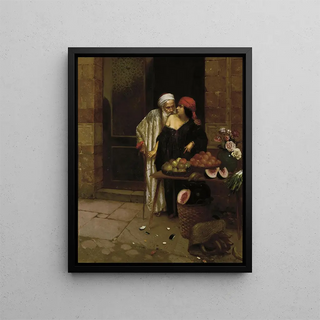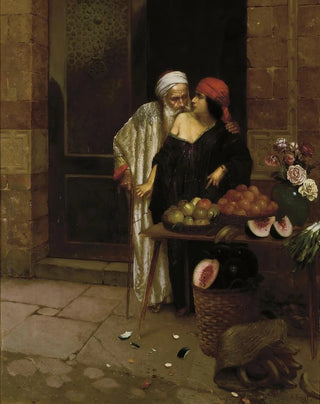Art print | The Orange Seller - Rudolf Ernst


View from behind

Frame (optional)
In the rich and vibrant world of Orientalist painting, "The Orange Seller" by Rudolf Ernst stands out for its ability to transport the viewer to the heart of a lively market, where colors and textures blend to create an enchanting atmosphere. This artwork, echoing European artists' fascination with Eastern cultures, invites a sensory immersion into a world that is both exotic and familiar. The scene depicts an orange seller, whose gaze expresses a calm wisdom, while the fruits, bursting with color, seem to almost vibrate under the light. The art print of this piece allows for rediscovering a frozen moment in time, where every detail tells a story.
Style and uniqueness of the work
Rudolf Ernst, through his mastery of realism, manages to capture not only the appearance of objects but also the very essence of daily life. "The Orange Seller" is a perfect example of his talent for representing textures. The oranges, in a vivid orange hue, contrast with the earthy tones of the market, creating a visual harmony that draws the eye. Light plays a crucial role in this piece, subtly illuminating faces and goods, while casting delicate shadows that add depth to the composition. This style, both detailed and poetic, allows the viewer to feel the warmth of the sun and the scent of the fruits, making the scene almost tangible.
The artist and his influence
Rudolf Ernst, an Austrian painter of the 19th century, is often associated with the Orientalist school, an artistic movement that flourished in Europe at that time. His passion for Eastern cultures led him to travel across the Ottoman Empire and North Africa, where he drew inspiration. Ernst stands out for his ability to combine impeccable technique with a sensitivity to the daily lives of the peoples he depicts. His works, while rooted in a historical reality, often transcend simple ethnographic documentation to become visual narratives filled with emotion. The impact of his work on Orientalist art is undeniable, and he paved the way for a deeper appreciation of

Matte finish

View from behind

Frame (optional)
In the rich and vibrant world of Orientalist painting, "The Orange Seller" by Rudolf Ernst stands out for its ability to transport the viewer to the heart of a lively market, where colors and textures blend to create an enchanting atmosphere. This artwork, echoing European artists' fascination with Eastern cultures, invites a sensory immersion into a world that is both exotic and familiar. The scene depicts an orange seller, whose gaze expresses a calm wisdom, while the fruits, bursting with color, seem to almost vibrate under the light. The art print of this piece allows for rediscovering a frozen moment in time, where every detail tells a story.
Style and uniqueness of the work
Rudolf Ernst, through his mastery of realism, manages to capture not only the appearance of objects but also the very essence of daily life. "The Orange Seller" is a perfect example of his talent for representing textures. The oranges, in a vivid orange hue, contrast with the earthy tones of the market, creating a visual harmony that draws the eye. Light plays a crucial role in this piece, subtly illuminating faces and goods, while casting delicate shadows that add depth to the composition. This style, both detailed and poetic, allows the viewer to feel the warmth of the sun and the scent of the fruits, making the scene almost tangible.
The artist and his influence
Rudolf Ernst, an Austrian painter of the 19th century, is often associated with the Orientalist school, an artistic movement that flourished in Europe at that time. His passion for Eastern cultures led him to travel across the Ottoman Empire and North Africa, where he drew inspiration. Ernst stands out for his ability to combine impeccable technique with a sensitivity to the daily lives of the peoples he depicts. His works, while rooted in a historical reality, often transcend simple ethnographic documentation to become visual narratives filled with emotion. The impact of his work on Orientalist art is undeniable, and he paved the way for a deeper appreciation of






